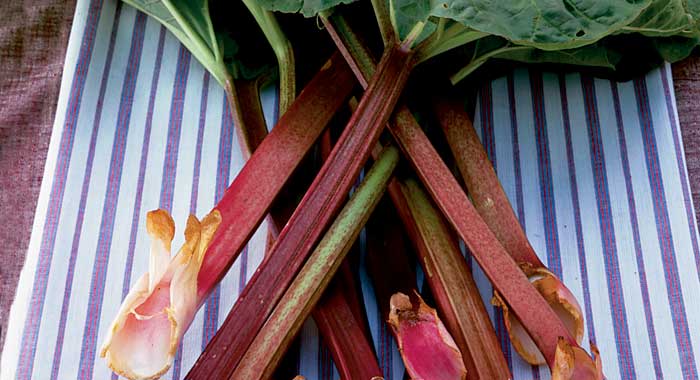
Pronounce it: roo-barb
Botanically, rhubarb is a vegetable (it’s related to sorrel and dock) but its thick, fleshy stalks are treated as a fruit, despite their tart flavour.
Rhubarb grows in two crops. The first, which arrives early in the year, is forced, grown under pots, particularly in what’s known as the ‘rhubarb triangle’ around Leeds, Wakefield and Bradford. Its stalks are watermelon pink, with pale lime green leaves, and it is the more tender and delicately flavoured of the two.
The second, called maincrop rhubarb, is grown outdoors, and arrives in spring. Its stalks are a deeper red, tinged with green, and its leaves a brighter green. It has a more intense flavour and a more robust texture than forced.
All rhubarb is too tart to be eaten raw, so should be cooked with plenty of sugar. It goes well with both ginger and strawberries.
Availability
Forced: January to early February. Maincrop: late March to June. You can try growing rhubarb in your garden or allotment, read more at the Royal Horticultural Society.
Choose the best
Go for firm, crisp, plump stalks and perky leaves with good colour.
Prepare it
Rhubarb leaves contain a poison, oxalic acid, so should never be eaten – cut them off and discard. Maincrop rhubarb can sometimes have some tough, stringly ribs so, after washing it, strip these off with a small, sharp knife then slice the stalk thinly or thickly as required. Forced rhubarb should be tender enough not to need peeling; just wash, then trim the top and bottom of the stalks and slice.
Store it
Rhubarb wilts quite quickly – store it in the fridge and eat within a couple of days. Keep the leaves on until you’re ready to eat it, as they’ll help keep it fresh.
Cook it
Stew or poach (8-10 minutes); roast (15 minutes for forced, 20 for main crop). Use to make crumbles, pies or jam. Roast and purée to make rhubarb fool.
Be the first to comment on "Rhubarb"